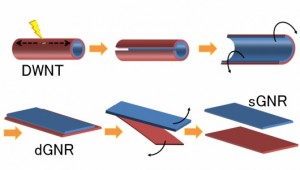A research group led by Professor Hirofumi Tanaka of Kyushu Institute of Technology discovered that by adsorbing organic nanoparticles on graphene nanoparticles, the area around the adsorption site becomes a semiconductor.It may be a material for next-generation semiconductor components that will replace silicon.
When graphene was discovered in 2004, researchers immediately tried to make it into a semiconductor all over the world.By connecting graphene as wiring and graphene made into semiconductors, I thought about making next-generation semiconductor parts.However, no effective method has been found yet.On the other hand, Professor Tanaka's idea was to partially semiconductorize the circuit formed from graphene to form a circuit in which wiring and devices are integrated.To that end, we first established a method for cutting out stable quality graphene nanoribbons from sheets.Next, by adsorbing certain organic compounds on the ribbon made by this method, we succeeded in partially converting it into a semiconductor.Since the non-semiconductor parts are used as wiring, the circuit formed by this method may be a very effective method for manufacturing new semiconductor parts.
Although the performance of the central processing unit (CPU) of computers is steadily improving even now, it cannot be denied that it has slowed down considerably compared to around 2000.The day may come when research from the material level will make dramatic progress again.


